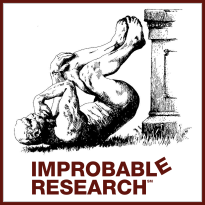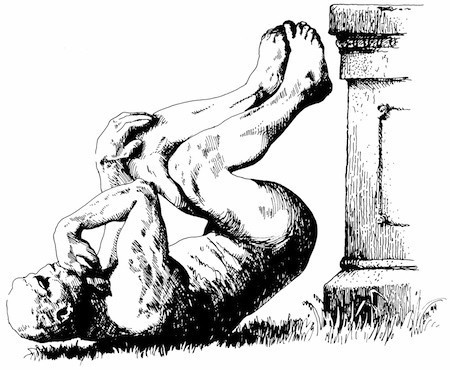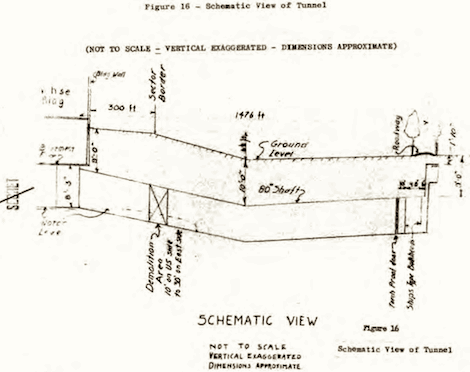Marc Abrahams's Blog, page 339
March 26, 2015
Why mathematicians (some of them) cackle at wobbly tables
Matthias Kreck explains, in this video made by Brady Haran for NumberPhile, a mathematical twist that fixes a wobbly table:
Podcast #4: The rectum of the Bishop of Durham
 The rectum of the Bishop of Durham is on display in this week’s Improbable Research podcast.
The rectum of the Bishop of Durham is on display in this week’s Improbable Research podcast.
The podcast is all about research that makes people LAUGH, then THINK — research about anything and everything, from everywhere —research that’s good or bad, important or trivial, valuable or worthless. CBS distributes it, both on the new CBS Play.it web site, and on iTunes.
Podcast #3: The Rectum of the Bishop of Durham
LISTEN on Play.it or iTunes. (Or DOWNLOAD it, and listen later)
SUBSCRIBE (to receive a new episode, FREE, every week) on Play.it or iTunes.
This week, Marc Abrahams tells about:
The rectum of the Bishop of Durham. (The rectum of the Bishop of Durham, on display at the Hunterian Museum / Simon Chaplin)
Imperial boredom. (Jeffrey Auerbach / Auerbach, Jeffrey (2005). ‘Imperial Boredom.’ Common Knowledge 11 (2): 283–305.)
Norman, the punk or accountant. (Louise Pendry / Pendry, Louise, and Rachael Carrick (2001). ‘Doing What the Mob Do: Priming Effects on Conformity.’ European Journal of Social Psychology 31: 83–92. / Bargh, John, Mark Chen, and Lara Burrows (1996). ‘Automaticity of Social Behavior: Direct Effects of Trait Construct and Stereotype Activation on Action.’ Journal of Personality and Social Psychology 71 (2): 230–44. / “The federal attack on organized crime“, Edwyn Silberling, Crime and Delinquency, vol. 8, 1962, pp. 365-370.)
Measured attitudes to chocolate. (Benton, David, Karen Greenfield, and Michael Morgan (1998). ‘The Development of the Attitudes to Chocolate Questionnaire.’ Personality and Individual Differences 24 (4): 513–20. / Cramer, Kenneth M., and Mindy Hartleib (2001). ‘The Attitudes to Chocolate Questionnaire: A Psychometric Evaluation.’ Personality and Individual Differences 31 (6): 931–42. / “Improving mail survey response rates using chocolate and replacement questionnaires,” Mike Brennan, and Jan Charbonneau, Public Opinion Quarterly, vol. 73, no. 2, 2009, pp. 368-378.)
Truth on the side. (Franco Fabbro / Fabbro, F. B., B. Gran, and A. Bava (1993). ‘Hemispheric Asymmetry for the Auditory Recognition of True and False Statements.’ Neuropsychologia (31) 8: 865–70. / Surwillo, Walter W. (1981). ‘Ear Asymmetry in Telephone-Listening Behavior.’ Cortex 17 (4): 625–32. / Jackson, Chris J., Adrian Furnham, and Tony Miller (2001). ‘Moderating Effect of Ear Preference on Personality in the Prediction of Sales Performance.’ Laterality: Asymmetries of Body, Brain, and Cognition 6 (2): 133–40.)
28 hours of vexations. (Kohlmetz, Christine, Reinhard Kopiez, and Eckart Altenmüller (2003). ‘Stability of Motor Programs during a State of Meditation: Electrocortical Activity in a Pianist Playing “Vexations” by Erik Satie Continuously for 28 Hours.’ Psychology of Music 31 (2): 173–86. / Kopiez, Reinhard, Marc Bangert, Werner Goebl, and Eckart Altenmüller (2003). ‘Tempo and Loudness Analysis of a Continuous 28-Hour Performance of Erik Satie’s Composition “Vexations”.’ Journal of New Music Research 32 (3): 243–58. / Recording of a complete nonstop performance of the music)
The mini-opera “What’s Eating You”, thrilling conclusion. (The opera premiered as part of the 2014 Ig Nobel Prize ceremony. It starred Maria Ferrante and Scott Taylor, with Patrick Yacono on piano and Thomas Michel on accordion. Karen Hopkin narrates. Also starring the Microbe Chorus: Kelsey Calhoun, Nicholas Carstoiu, Delphine Gabbay, Paul Goodwin, Clia Goodwin, Erika Hutchinson, Andrew B. Jones, Julia Lunetta, Sylvia Rosenberg, Daniel Rosenberg, Abby Schiff, Ted Sharp, and Nobel laureates Carol Greider, Rich Roberts, Frank Wilczek, and Eric Maskin.)
The mysterious John Schedler did the sound engineering.
March 25, 2015
Estimating intranasal volume – the easy way
 One way to measure a human subject’s intranasal volume is to perform a structural whole-brain T1-weighted MRI scan, and then use computerised volumetric image analysis software on the resulting data. But is there an easier way?
One way to measure a human subject’s intranasal volume is to perform a structural whole-brain T1-weighted MRI scan, and then use computerised volumetric image analysis software on the resulting data. But is there an easier way?
Yes, there is, according to a group of researchers from the Taste and Smell Clinic, University Hospital Carl Gustav Carus, Dresden, Germany, the Monell Chemical Senses Center, Philadelphia, United States, the Dept. of Psychology, University of Pennsylvania, Philadelphia, United States, the Dept. of Clinical Neuroscience, Karolinska Institutet, Stockholm, Sweden, and the department of Diagnostic and Interventional Neuroradiology, RWTH Aachen University, Aachen, Germany, just look at the size of their nostrils (the subject’s, not the researchers).
“It is well documented that size of various body parts tends to correlate within the same individual.”*[1] they say, and, based on this premise, they decided to investigate the possible validity of their simple test. See: ‘Size of nostril opening as a measure of intranasal volume’ in: Physiology & Behavior, Volumes 110–111, 17 February 2013, Pages 3–5
“Our results suggest that the intranasal volume is positively correlated with the area of the nostril opening. Intranasal volume did not differ significantly between men and women although men had significant larger nostril openings. However, the correlation between intranasal volume and nostril opening was not influenced by the subject’s gender. In conclusion, it is possible to obtain a good estimate of the intranasal volume using measurements of the nares.*[2]”
A full copy of the paper may be found here [click: Full Text]
* Notes:
[1] “For example, a tall individual with long legs also tends to have long arms.”
[2] “Nares” is pronounced to rhyme with ‘Fairies’ rather than ‘Fairs’
March 24, 2015
Ig Nobel shows in Aarhus (Wed, Thurs) and Copenhagen (Fri)
 The 2015 Ig Nobel EuroTour descends on Denmark this week. Here are the details:
The 2015 Ig Nobel EuroTour descends on Denmark this week. Here are the details:
AARHUS UNIVERSITY, Denmark, Aarhus. The Ceremonial Hall. Wednesday and Thursday, March 25 & 26, evening. (TICKETS). (NOTE: There are also optional events immediately before and after each Aarhus show. BEFORE the show, there is a BUFFET —separate tickets are required for the buffet . AFTER the show, there is a reception — free, no tickets required — for every one, at the Steno Science Museum.) Featuring: Marc Abrahams ; Dr. Nakamats (Ig Nobel winner, photographing every meal he has consumed over a period of 43 years); Hynek Burda (Ig Nobel winner, Documenting that when dogs defecate and urinate, they prefer to align their body axis with Earth’s north-south geomagnetic field lines); Jaroslav Flegr (Ig Nobel winner, Is it mentally hazardous for a human to own a cat); Eigel Reimers (Ig Nobel winner, Testing how reindeer react to seeing humans who are disguised as polar bears); and a special appearance by LFFFHCfS member Halfdan Skjerning and his beard. NOTE: The shows in Aarhus will be live-streamed to six towns in Jutland, Germany, the Faroe Islands, and Greenland.
UNIVERSITY OF COPENHAGEN, Denmark. Festsalen, Frue Plads 4, 1168 København. Friday, March 27, 7:00 pm. ( TICKETS .) Featuring: Marc Abrahams; Dr. Nakamats (Ig Nobel winner, photographing every meal he has consumed over a period of 43 years); Hynek Burda (Ig Nobel winner, Documenting that when dogs defecate and urinate, they prefer to align their body axis with Earth’s north-south geomagnetic field lines); Jaroslav Flegr (Ig Nobel winner, Is it mentally hazardous for a human to own a cat); Eigel Reimers (Ig Nobel winner, Testing how reindeer react to seeing humans who are disguised as polar bears)
BONUS: Dr. NakaMats discusses his ideas for better ideas
BONUS: The complete tour schedule (next week: Sweden).
The physics of a falling slinky
A slinky behaves in ways that might surprise you, unless you have really, really thought through the physics of it. This three part video shows all, in beautiful slow motion:
BONUS: And a bit more action:
(Thanks to investigator Wayne Osterfeld for bringing this to our attention.)
March 23, 2015
Sneeze catcher (new patent)
It’s a given that all manner of unwelcome microbial and viral particles can be exhaled by a person during a sneeze or a cough. Prompting inventor Joseph Apisa of Colts Neck, NJ, US, to create a ‘Sneeze catching method and apparatus’ It’s just received a US patent (Dec. 16, 2014). It can be, and indeed is, described in one sentence :
“An apparatus for catching bodily fluids ejected during a sneeze or cough, said apparatus comprising: a sleeve having a first open end, a second open end and a perimeter wall being attached to and extending between said first and second open ends; a frame being pivotally coupled to said perimeter wall, said frame having an exterior edge, an interior edge, an upper surface and a lower surface, said frame having an attached edge and a free edge positioned opposite of each other, said attached edge being attached to said perimeter wall, said frame being positioned in an open position having said free edge spaced from said sleeve or in a closed position having said free edge secured to said sleeve, said frame bounding a receiving space when said frame is in said closed position; a covering being attached to and being coextensive with said interior edge, said covering extending over said receiving space, said covering being comprised of an air and fluid permeable material; a closure being mounted on said sleeve and releasably retaining said frame in said closed position; a pad being removably positioned in said receiving space, said pad having anti-bacterial properties; and wherein said sleeve is configured to be worn on an arm of a person such that the person may sneeze or cough into said pad and that said pad captures and destroys bacteria exhaled by the person.“
Note re. Apostrophic Insufficiency: Improbable inquiries regarding the lack of apostrophe in Colts Neck have met with very little, if any, success. There are (unsubstantiated) rumours that apostrophes were long ago dropped at the insistence of nautical map-makers who felt that they could be mistaken for rocks (the apostrophes not the map-makers.)
March 22, 2015
Celebrating William Topaz McGonagall, for World Poetry Day
Steve Farrar celebrates the historically bad poetry of William Topaz McGonagall, for World Poetry Day:
… Here was a man unafraid to rhyme ‘poet’ and ‘know it’ without the least hint of irony, and of course he fearlessly rejected the confines of conventional scansion. For instance, he lovingly crafted the following couplet about Lochleven Castle:
‘And the scenery around it is most beautiful to be seen,
Especially the Castle, wherein was imprisoned Scotland’s ill-starred Queen.’
Ig Nobel Prize winner Lee Kuan Yew dies in Singapore
Lee Kuan Yew, who was awarded the 1994 Ig Nobel Prize for psychology, has died, say numerous press reports.
His Ig Nobel citation said that the prize honored: “Lee Kuan Yew, former Prime Minister of Singapore, practitioner of the psychology of negative reinforcement, for his thirty-year study of the effects of punishing three million citizens of Singapore whenever they spat, chewed gum, or fed pigeons.”
Reuters reports about his death:
Lee Kuan Yew, Singapore’s first prime minister and architect of the tiny city-state’s rapid rise from British military outpost to global trade and financial center, died on Monday aged 91….
Lee, a British-educated lawyer, is widely credited with building Singapore into one of the world’s wealthiest nations on a per capita basis with a strong, pervasive role for the state and little patience for dissent…. He advocated free-wheeling market capitalism while keeping tight control over social behavior, from banning chewing gum to caning those caught painting graffiti on public property.
History of surveying: Berlin Spy Tunnel
This document, billed as a US government secret history of a surveillance tunnel dug in Berlin during the cold war (“Clandestine Services History: The Berlin Tunnel Operation 1952-1956“, CS document #150), tells of a difficult moment for the surveyors:
The lack of an adequate base line made the surveying problem especially difficult. The engineers decided at one point that an object of known size in the East Zone would be useful as a reference point, so a baseball game was organized with the objective of knocking a baseball as far into the East Zone as possible. This scheme was frustrated by the friendliness of the East German guards who kept returning the baseball. Nonetheless, the engineers expressed confidence that they knew their position when the tunnel was completed to a point which could be contained in a six-inch cube. They were correct.
March 21, 2015
The Ho Ho Classification and Nomenclature Committee Report
Copies of this report on Ho Ho Classification and Nomenclature are now hard to come by:
“The Ho Ho Classification and Nomenclature Committee Report,” Johan Kamminga, Maxine Kleindienst, Ruthann Knudson, and Robert Lawrence, Lithic Use-wear Analysis, 1979, pp. 133-35.
BONUS (unrelated): Huh
Marc Abrahams's Blog
- Marc Abrahams's profile
- 14 followers






